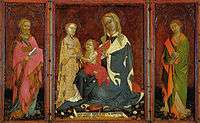Lorenzo Salimbeni
Lorenzo Salimbeni (San Severino Marche 1374-c1418) and Jacopo Salimbeni (c.1370/80-after 1426), brothers had careers that spanned in both relatively narrow area and short time, from the triptych painting of the altarpiece of the Mystical Marriage by Lorenzo alone in 1400 (Pinacoteca Civica, San Severino) to the frescoes of the Crucifixion and Scenes from the Life of St John the Baptist in the Oratory of St John the Baptist, Urbino, in 1416. However, the major part of their work is to be found in churches in and around their home town, San Severino Marche.[1]

Works
The role as scholar of the older brother, Lorenzo is more relevant: many known works are signed by him alone, but anyone is undoubtedly ascribable to Jacopo. Several Salimbenian works can be viewed in San Severino: some frescoes coming from the old cathedral and depicting the episodes of Saint John the Evangelist, have been reassembled in the vault of Civic Pinacotheca in San Severino. The two painters frescoed the Basilica of San Lorenzo in Doliolo, the San Domenico Church and the old Cathedral of Saint Maria della Pieve in San Severino.
In spite of his great artistic production the majority of his paintings are scattered through both Marche and many important museums in all the world,[2][3] with only three valuable paintings being displayed in the Civic Pinacotheca of San Severino: the Virgin Mary in throne with the Child among Saints John Baptist and Agostino, the Pietà [4] the Nativity. In Saint Mary of Majesty church in Parolito, a town very close to San Severino, are conserved five frescoes ascribed to D’Alessandro.
Along with Lorenzo’s brother Jacopo, they painted frescoes of John the Baptist in Urbino. He painted an altarpiece of Madonna and child with St. Catherine receiving ring and St Domenic and glory of angels for the church of Santa Lucia in Fabriano, now displayed in the National Gallery of London.[5]
In spite of their production was limited to few provinces of east-central Italy, their stylistic elements are representative of the internationalization of that pictorial language.
Notes
| Wikimedia Commons has media related to Lorenzo Salimbeni. |
- Salimbeni from marchworldwide.org Archived 2003-01-31 at the Wayback Machine
- National Gallery of London Marriage of Saint Catherine of Siena
- Uffizi Gallery of Florence Pietà
- The Pietà www.septempeda.it, Pinacotheca of San Severino Marche
- Farquhar, Maria (1855). Ralph Nicholson Wornum (ed.). Biographical catalogue of the principal Italian painters. Woodfall & Kinder, Angel Court, Skinner Street, London; Digitized by Googlebooks from Oxford University copy on Jun 27, 2006. p. 158.